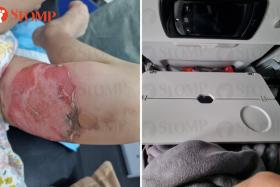‘No intact bodies’ in grim Air Algerie crash probe
French experts are sifting through the debris of the Air Algerie plane that disintegrated over the northern Mali desert last week, killing all 118 on board.
After days of meticulous searching, they have yet to see a single intact body around the remote crash site at the southern edge of the Sahara desert.
Mr Sandwidi Rodrigue, who lost a parent in the accident, was able to speak to experts on the crash site.
“They told us they have recovered hundreds of parts of victims. But all that could be the remains of two or three people,” he said.
Flight AH5017, which took off early Thursday morning from Ouagadougou in neighbouring Burkina Faso bound for Algiers, went missing amid reports of heavy storms.
There were 54 French nationals, 23 Burkinabe, and nationals of Lebanon, Algeria, Spain, Canada, Germany and Luxembourg on board.
Badly broken bodies
Experts – gendarmes, police and a team from France’s plane crash investigation agency BEA – are combing the area one square metre at a time.
In addition to body parts or items that could help identify the victims, experts are looking for clues as to why the aircraft was obliterated.

Investigators gathering evidence at the crash site.
“We realised right away that we would have to go straight to DNA analysis,” said Colonel Patrick Touron, deputy head of the French gendarmerie’s Criminal Research Institute.
“We saw that we had no intact bodies... just very badly broken bodies which weren’t identifiable using the classic forensic methods, dental records and fingerprints.”

Investigators from various countries talking at the crash site.
Several hundred soldiers – French, Malians and troops in MINUSMA, the UN peacekeeping mission in Mali – have secured the site.
French Chief of Staff General Pierre de Villiers told AFP in Paris: "Our job is to provide logistical support to French investigators, and their Malian, Algerian and Spanish colleagues."
Searing heat threatens evidence
Temperatures in northern Mali can exceed 40 deg C in July and an urgent task for the investigators is protecting evidence from the sweltering heat.
“The molecular biology techniques require meticulous sample preservation. Time here is against us. It is very hot and the samples become degraded very quickly,” said Col Touron.
Samples lifted from the debris are being taken to two white tents marked National Gendarmerie.

Tents set up at the crash site.
In another tent, experts retrieve samples from victims’ relatives who have been transported from Ouagadougou.
“It is imperative that we get the DNA of relatives so that we can then try to identify a brother, a father, a sister... The more information we have, the more rapid will be the identification,” said Col Touron.
All that remains
Mr Bassindua Laurent, whose oldest brother and a friend were killed in the crash, left a bouquet of flowers on the periphery of the secure area and broke down, his head in his hands.
He told AFP he would take a mixture of ash and sand from the site “as a testament to the horror that took place in Gossi”.
“This is all that remains of what is most dear to us. We will keep this in our family... I hope from my heart all these people rest in peace,” he said.

A man crying as he pays homage to his young brother, who was on board Air Algerie flight AH5017, at the crash site in Mali's Gossi region.
Source: AFP
Get The New Paper on your phone with the free TNP app. Download from the Apple App Store or Google Play Store now


